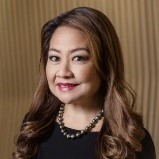ASB Female Leaders Star in Hawaii Business Magazine
By
ASB October 03, 2018 | 5 min read N/A
American Savings Bank is proud to be a company that supports the development of female leaders. This month, Hawaii Business Magazine featured ASB in “The Wahine Issue.” Read on to learn all about how our women leaders are helping each other and our teammates move up in corporate Hawaii.
Feel free to steal these ideas – they might work at your company too!

Dani Aiu, executive VP of consumer banking, American Savings Bank
Dani Aiu’s prestigious career in banking began with her natural ability to talk story with the tellers at the Manoa branch of Bank of America.
The 19-year-old community college sophomore knew them all by name and enjoyed the warm rapport each time she walked in. “I was working at Longs in Manoa and was a customer at the bank, and the manager approached me and asked me if I would be interested (in a part-time job). It definitely wasn’t something I was looking at, but it was an opportunity.”
Twenty-six years later Aiu is executive VP at American Savings Bank – which acquired the local Bank of America branches years ago. Now she is responsible for ASB’s call center, home loans, consumer banking, insurance, investments, business banking and 500 employees in 49 branches.
Of the nine people in top leadership at ASB, four are women, and Aiu says the support of women leaders is a powerful piece of the bank’s DNA.
“You see the support,” says Aiu. “Companywide we talk about speaking up and collaborating, about what’s best not just for our customers, but for our teams. In my career I’ve always aspired to do more. And they have always been there for me.”
While few women are CEOs of large Hawaii companies, more and more are earning their way into senior leadership positions. Those companies with lots of female leaders include ASB, HMSA, Hawaii Dental Service, Castle Medical Center and Hawaiian Electric Industries – the latter two are actually run by female CEOs. The presence of women as leaders is not accidental; all of these organizations support both their male and female managers and help the best and the brightest to advance.
There is no easy path to the top – especially in industries men have dominated – but Hawaii’s female leaders say several factors improve your odds of success: personal determination, hard work, good education, support from both women and men within the company, plus support from spouses, significant others and parents. Luck also plays a role.
These women also talk about passion for their jobs, and typically start their days before the sun is up and get home long after it has set. They often live on takeout food while balancing careers, families, other interests and their own well-being. And each says it matters how their companies have and continue to support and nurture them and other aspiring female leaders.
Each company provides that support differently. At HMSA, where nine of the 13 top leaders are women, people in many parts of the organization are offered flexible work schedules, which often helps women with families to set hours that support their personal needs.
At Hawaii Dental Service, which insures a million people, six of the 13 top leadership positions are held by women. “When I started 28 years ago it was male dominated, so it was tough,” remembers Cheryl Takitani-Smith, CFO at HDS. “But the company believes in nurturing and developing me. There were two others (who came aboard at the same time) and they hired coaches for us, and we still do that today. The opportunities came through that coaching.
“And I was fortunate to work with CEOs who placed the importance on what you could contribute to the company, regardless of your gender,” says Takitani-Smith.
Gwen Miyasato, executive VP at HMSA, has a similar story. Miyasato has 40 years at the health insurance company, starting as an analyst evaluating how patients used medical services.
“I was one of those very spirited women’s lib type of people,” she says with a chuckle, “and I had six or seven men at my first job interview. They were very nice but it was just interesting I would have so many people interviewing me and secondly that they would all be men.”
Miyasato moved up gradually, being assigned more responsibility every 18 months or so. “I never asked for it, it wasn’t in my plan, but I obviously said ‘Yes’ when they gave me more and I tried hard to get all of it done.”
As Miyasato’s career grew, so did the support systems for women. HMSA’s CEO has always been available for consultations, she says, and projects offering new challenges as well as additional upward mobility have been readily available.
“Those projects allowed people to see what they could do beyond their own work area,” says Miyasato. “Now we have the Emerging Leaders program that started with maybe 20 people and now there are 200. It’s a mentoring network and community service group. It gives a lot of people who might not have face time with executives that opportunity.”
Support at ASB has also grown: The ASB Women’s Network, which meets quarterly, and the Leadership Academy were both put in place by Beth Whitehead, executive VP and chief administrative officer.
American Savings Bank has also created an Employee Excellence Council of about 50 people to focus on what it means to be a great place to work and how to achieve that, says Whitehead. The company has also created Leadership Labs – monthlong explorations of leadership issues – as well as Leadership Forums that are daylong gatherings twice a year for all company leaders, “focusing on leadership topics.”
ASB’s Leadership Academy is based on the Omidyar Fellows – 15 months of leadership training for a cohort of people who are ready for career expansion. The fourth cohort of 12 to 16 people launches this fall.
The ASB Women’s Network brings women together quarterly to focus on what is unique for women in leadership roles, and what kind of support they may need. “We take on things that are practical and slightly uncomfortable and unique to women,” Whitehead says. “For instance, we took on a discussion around #MeToo and why it is so hard to speak up.” The discussion made sure everyone knows the boundaries and is more willing to speak up if there are issues.
“I think it’s a more comfortable conversation in a roomful of women leaders who trust each other.”
Another discussion covered juggling being mothers and business leaders. “It’s really great to feel like someone else has the same issue,” Whitehead says. “We are all in this together and we are here to support each other.”
Aiu certainly understands that. Her work ethic often conflicted with the demands of her family, and along the way she forced herself to balance those needs. Now she makes sure to give time to family vacations, as well as exercise workouts while still giving the job 100 percent.
Her friendliness and empathy for others have contributed to her success, but so has hard work. She’s up at 4:30 every morning, drops her two sons at school and gets to the office by 6:45 for a 12-hour day that is partly organized around her husband’s duties with the Honolulu Police Department.
Kathryn Raethel, CEO at Adventist Health, which operates Castle Medical Center, also regularly puts in 10- to 12-hour days at the hospital. Raethel has spent a lifetime working within the Adventist Health System on the West Coast and in Hawaii, and says the company invests in building leaders by spending thousands of dollars annually on a variety of development courses as well as subsidizing the further education of employees.
“They provide funds to attend programs,” says Raethel. “They provide the funding for you to make that advancement. Every director here has the opportunity to travel to the Mainland once every two years for an educational opportunity. We’ll cover their airfare and hotel for these learning experiences.”
The top two leaders at Castle are women: Raethel as president and CEO, and Laura Westphal as VP of patient care. Raethel says Castle provides a level playing field so people advance based on skill, not gender. “If you excel in your job, they recognize that and reward that,” she says.
“As the chief nurse back in 2011, the CEO role opened up unexpectedly and I put my hand up and said, ‘Choose me.’ I know the organization, I love the organization and I think I could do the job really well. They had never had a woman CEO and I was asking them to do something they had never done before. And they did.”
Other support includes a nearby day care center for employees and their children, an Emerging Leaders program and a Leadership Institute that provides training for up-and-coming employees, similar to the programs at HMSA and ASB.
“I’ve done a lot of work in developing talent behind me,” says Raethel. “Hopefully I’ve prepared some younger executives.”
But much of the drive must come from individuals themselves, she says. “We prefer to promote from within,” Raethel says, noting that people who take on challenges and exhibit skills are nominated for programs that help them move forward.
Taking on new challenges is a universal trait of successful female leaders. Gina Marting, HMSA’s senior VP and CFO, speaks about having the courage and self-confidence to accomplish what you want to do, and the support within your organization to do your job.
“As a woman you have to have a lot of self-confidence to walk into a room when it’s all men,” says Marting. “You have to look past that and have the courage to say what you have to say.”
Jennifer Walker is an example of how HMSA supports women moving up the leadership ladder. She joined the company in 2010 as an attorney in the legal department. Within two years she was promoted to executive VP, and two years later to senior VP and general counsel.
At first, she wondered if she could do that tough job.
“Another woman leader said to me, ‘You know Jenny, just own it,’ and that changed the way I acted. She told me, ‘You deserve where you are, and you need to own it and show your confidence.’ So I started talking more and contributing more, and as a result they started consulting me more, inviting me to more strategic conversations, and I had a seat at the table more often. I have a number of young women who I mentor here now and it really comes down to confidence, and being resilient. A lot of women doubt they can do something and don’t know if they’re good enough or smart enough. I see the exact opposite when I see them. So it’s helping them build confidence and know they have as much to offer as anyone else.”
Leadership is also about understanding other viewpoints, says Janna Nakagawa, executive VP at HMSA handling overall strategy.
“When I was a young attorney I got some great advice from a female mentor. She wasn’t my boss but we were collaborating on a case. One of the biggest lessons I learned from her was always put yourself in another person’s shoes. If you’re making an argument, or evaluating anything, situate yourself in that other person’s shoes and see it from their perspective. Any time you do that you will come out with more understanding and a better perspective to move forward.”
Janna Nakagawa, left, is one of nine women on the executive leadership team at HMSA. She is also one of the mentors for Janna Fong Hoshide.
The advice Nakagawa received was an example of mentoring, which is vital for anyone moving up the career ladder. Nat Taniguchi, executive VP handling enterprise risk and regulatory relations at American Savings, chuckles when she remembers a conversation with an administrator back when she was 27 and working at Hawaiian Electric Industries, the parent company.
“I was helping to raise money and manage the pension portfolio,” says Taniguchi. “I actually thought I’d found my forever job. I loved it. I was already thinking about my retirement and they had a really good retirement plan and that was great.”
Then she was approached to work at the company’s international subsidiary, building power plants in China, the Philippines and Guam.
“At first I said no, because I loved my job,” says Taniguchi. “One of my mentors was head of administration and he talked to me and said, ‘What 20-something-year-old is thinking about retirement? For goodness sakes! You can gain so much experience and broaden your horizons, and if it doesn’t work you can do so many other things.’ It was hard for me, but in hindsight it was a good move. It made me realize there are a whole lot of other fun things that you could do, and it allowed me to gain so much experience in so many different areas. A lot of times you don’t realize that until you have gone through the experience.”
Now 58 and constantly tackling new challenges, Taniguchi can’t even imagine retirement.
“I love my job,” she says. “I just want to continue to contribute to make this a place made up of high-performing teammates. The position I have now at ASB takes care of looking at risks across the organization. It’s never the same thing every day. It’s really, really fun.”
20 Tips: Leadership advice from 10 women who cracked the local glass ceiling
1. Have a positive outlook.
“You tend to attract others who want to work with you and mentor you.”
– Dani Aiu, executive VP of consumer banking at American Savings Bank
2. Develop a can-do attitude.
“Be really tenacious and know what you’re good at and set goals and be the best you can be. You get noticed when you do that. When someone asks you to do something, grab it with both hands and give it your best. If a door opens, go through it with gusto.”
– Kathryn Raethel, CEO of Adventist Health Castle
3. Find mentors who will be honest with you while helping you learn.

“Be open to constructive feedback. I found people who I believed could be honest with me.”
– Nat Taniguchi, executive VP overseeing enterprise risk and regulation relations at American Savings Bank
“It’s not helpful for people to tell you what you want to hear. You want people who can give you constructive feedback and have the experience to help you look forward.”
– Janna Nakagawa, executive VP of strategy for HMSA
4. Set goals but don’t be afraid to change them.

“It’s great to have a goal, but focusing too much on the end result may make you miss something on the journey. So focus on how do you broaden your skills and stay fresh in what you’re doing. Often the path is unpredictable.”
– Beth Whitehead, executive VP and chief administrative officer, ASB
5. Surround yourself with awesome people.
“We wouldn’t be able to do what we do without the people we have on board. When we hire it takes us awhile to get the right person. A lot has to do with your passion and how you look at what you want to do.”
– Cheryl Takitani-Smith, CFO of Hawaii Dental Service
6. Support other people.

“Years ago I attended a Wahine Forum and there was a session on Sheryl Sandberg and ‘Lean In.’ With a friend we started our own ‘Lean In Circle’ with friends from different industries and different companies. Sometimes work gets hard and challenges are different (for each one of us) but this group of women gets together once a month and has a beneficial talk.”
– Ann Teranishi, executive VP of operations at ASB
7. Have courage.
“It’s being able to share openly and honestly about things you see that might be controversial, and also asking the questions.”
– Gina Marting, senior VP and CFO at HMSA
“You need to take risks and get out of your comfort zone. As one of my mentors constantly reminds me: It’s short term-pain for long-term gain.” (Takitani-Smith)
8. Maintain a flexible attitude and a willingness to change.
“In a very results-driven environment you need to know when a change is needed. It’s that insanity rule: Doing the same thing over and over will not get you there. So it’s important to be able to strategically identify and recognize a need to change behavior and bring others along.” (Aiu)
9. Don’t be afraid to fail.
“People often shy away from taking on things they haven’t done before. But when you’re known as a good person who is going to take on something new and learn it the best you can, that opens doors for you. I fail at least once or twice a day but you try to fail in a contained way. There are maybe 12 ideas that are really bad and maybe one or two are really amazing, so failing in some of your ideas but getting to a great result is part of the game.” (Whitehead)
10. Don’t be afraid of what seem to be hard assignments.
“Jump in and work really hard and surround yourself with people you can bounce ideas off or tap into.” (Taniguchi)
11. Acquire hands-on experience.
“You learn so much through being in various situations. I really found being in the front line of banking – I started as a teller – engaging customers teaches you a lot.” (Aiu)
“The broader your experience, the better you’re known as someone who gets things done.” (Whitehead)
12. Be true to yourself.
“Don’t compromise the values you have. Be willing to hear and consider the other side, but don’t necessarily make that change your mind entirely.” (Nakagawa)
13. Speak up.
“What you have to say is not so crazy. It will be well received.” (Teranishi)
14. Build your resiliency.
“You’re going to face things that disappoint you and challenges that you’ll have every day. When you’re in a finance role a lot of times you have to be the bad guy and the one who says no. So it’s being able to weather that negativity or the pushback from others. … You are thinking of the greater good, not just today’s impact.” (Marting)
15. Practice your presentation.
“We had one session of coaching to see how you’re presenting yourself. One point was to practice lowering your voice so you don’t sound like a little girl talking. What women also do a lot of times when they’re nervous or insecure is they start fidgeting with their hair or playing with their jewelry. You need to slow down and speak clearly. Women tend to speak at a much faster pace than men and that tends to look a little flighty. So calm yourself and gather your thoughts and that helps command respect.” (Takitani-Smith)
16. Volunteer to do new things.
“Take on new challenges and grow and learn from mistakes and find new things that you didn’t even know you could do. The best people to pick for internal promotions are people who have well-rounded assignments here and have done various different things and really understand how a bank works.” (Whitehead)
17. Find your passion.
“Find something that you really love doing because if you do, you’ll end up doing a really great job. And surround yourself with really smart people because together you can do so much more. I think the people you work with are more than half of what makes a job a great job.” (Taniguchi)
18. Solve problems by looking at the big picture.
“Step back and evaluate what is the situation. How significant is this (issue)? What are the goals and objectives? Why are we doing this? People so quickly dive in, but it’s very critical where we apply our resources so we have to constantly ask, ‘What are our goals? What’s our strategy here?’ ” (Takitani-Smith)
19. Lean on others so you don’t neglect your family.
“When I talk to young women starting families I want to make sure I tell them that’s really important and it doesn’t last forever. So find that balance. I was just lucky that my husband was able to be sort of mom and dad to our daughter. I think the reason for my success is my husband. He cooks, cleans, everything.”
– Gwen Miyasato, executive VP at HMSA
20. Be patient.
“Things will work out. Stay positive, stick to your values. Don’t be so eager to chase a bigger paycheck.” (Takitani-Smith)




